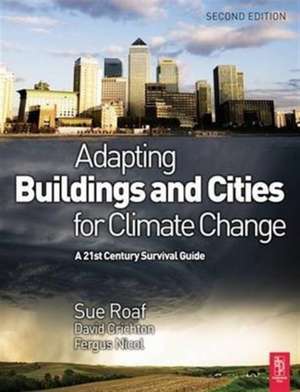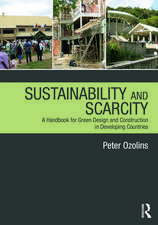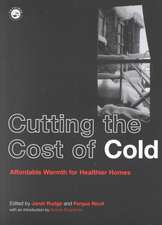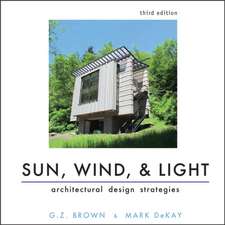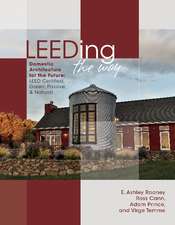Adapting Buildings and Cities for Climate Change
Autor David Crichton, Fergus Nicol, Sue Roafen Limba Engleză Hardback – 6 mai 2016
Three new chapters present evidence of escalating rates of environmental change. The authors explore the growing urgency for mitigation and adaptation responses that deal with the resulting challenges.
- Theoretical information sits alongside practical design guidelines, so architects, designers and planners can not only see clearly what problems they face, but also find the solutions they need, in order to respond to power and water supply needs.
- Considers use of materials, structures, site issues and planning in order to provide design solutions.
- Examines recent climate events in the US and UK and looks at how architecture was successful or not in preventing building damage.
Preț: 1000.27 lei
Preț vechi: 1219.84 lei
-18% Nou
Puncte Express: 1500
Preț estimativ în valută:
191.43€ • 199.11$ • 158.03£
191.43€ • 199.11$ • 158.03£
Carte tipărită la comandă
Livrare economică 15-29 aprilie
Preluare comenzi: 021 569.72.76
Specificații
ISBN-13: 9781138140554
ISBN-10: 1138140554
Pagini: 400
Dimensiuni: 189 x 246 mm
Greutate: 0.45 kg
Ediția:Revised
Editura: Taylor & Francis
Colecția Routledge
Locul publicării:Oxford, United Kingdom
ISBN-10: 1138140554
Pagini: 400
Dimensiuni: 189 x 246 mm
Greutate: 0.45 kg
Ediția:Revised
Editura: Taylor & Francis
Colecția Routledge
Locul publicării:Oxford, United Kingdom
Public țintă
Professional Practice & DevelopmentCuprins
Preface; Acknowledgements; Climate change - the battle begins; The evolution of buildings; Risk, scenarios and climate change; How hot will it get?; Thermal comfort ; How wet will it get?; Wind storms; Sea level rises; Vulnerability, exposure and migration; Air-conditioning ? the ultimate solution?; Tall buildings; The fossil fuel crisis; Fuel security - when will the lights go out?; The players; Resilient buildings; Adapting Buildings for climate change; Adapting Cities for climate change; Adapting Lifestyles for climate change;
Recenzii
"The book is a worthy second edition, presenting the reader with a restructured and retooled discussion about climate change, the substantial risks it poses to communities across the world, and the potential negative impacts it can have on these communities, while emphasizing the central role played by buildings and communities."
Hazem Rashed-Ali, SBSE News
"This is a real must-have on the shelf of all who are either involved or consulted on building design for the future and is a well-researched book written by someone who has a true passion for saving the planet."
Graham Shone, Building Engineer
About the first edition:
'A timely and fascinating book on the crucial issue of energy use in buildings which accounts for half of our total energy use.'
Stephen Tindale, Executive Director, Greenpeace, UK
Hazem Rashed-Ali, SBSE News
"This is a real must-have on the shelf of all who are either involved or consulted on building design for the future and is a well-researched book written by someone who has a true passion for saving the planet."
Graham Shone, Building Engineer
About the first edition:
'A timely and fascinating book on the crucial issue of energy use in buildings which accounts for half of our total energy use.'
Stephen Tindale, Executive Director, Greenpeace, UK
Notă biografică
Authored by Crichton, David; Nicol, Fergus; Roaf, Sue
Descriere
From the bestselling author of Ecohouse, this fully revised edition of Adapting Buildings and Cities for Climate Change provides unique insights into how we can protect our buildings, cities, infra-structures and lifestyles against risks associated with extreme weather and related social, economic and energy events.
Three new chapters present evidence of escalating rates of environmental change. The authors explore the growing urgency for mitigation and adaptation responses that deal with the resulting challenges.
Three new chapters present evidence of escalating rates of environmental change. The authors explore the growing urgency for mitigation and adaptation responses that deal with the resulting challenges.
- Theoretical information sits alongside practical design guidelines, so architects, designers and planners can not only see clearly what problems they face, but also find the solutions they need, in order to respond to power and water supply needs.
- Use of materials, structures, site issues and planning in order to provide design solutions is considered.
- Recent climate events in the US and UK and looks at how architecture was successful or not in preventing building damage is examined.
